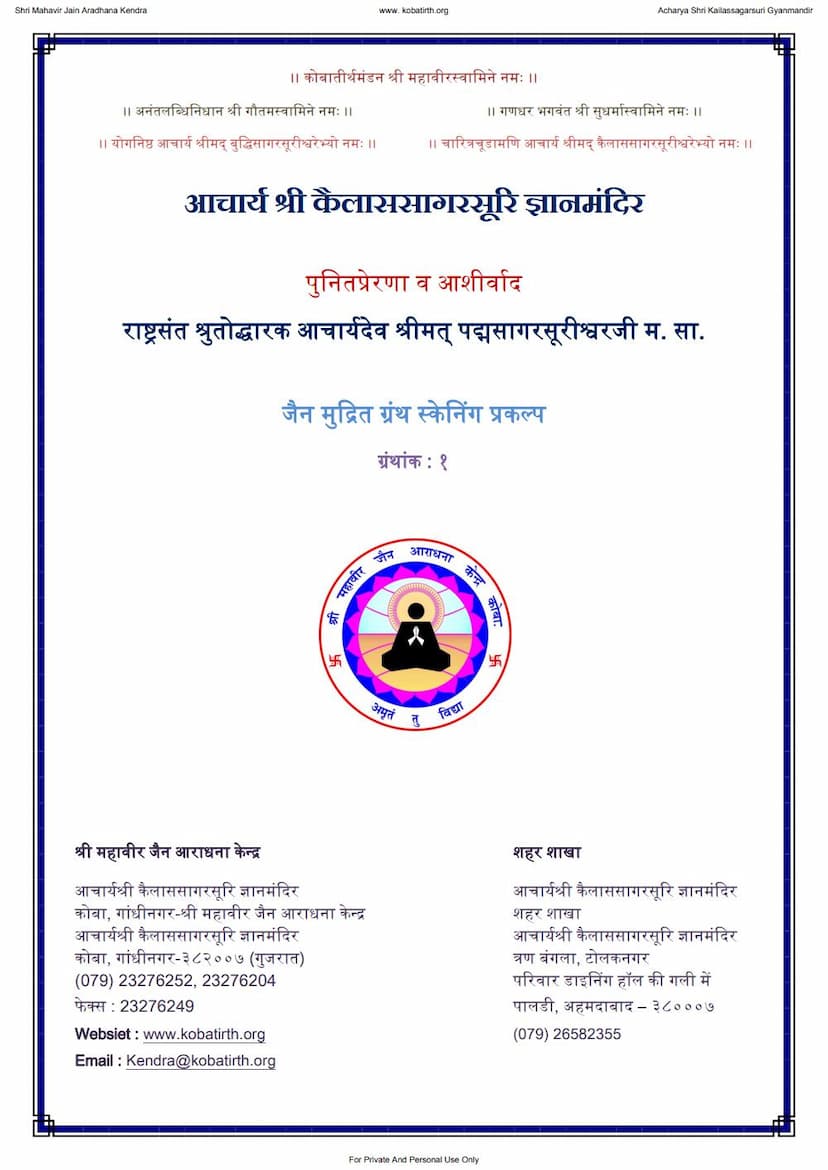Jivvichar
Added to library: September 2, 2025

Summary
This comprehensive summary outlines the Jain text "Jivvichar" (जीव विचार), authored by Shantisuri and translated by Vrajlal Pandit. The book, published by Atmanand Jain Pustak Pracharak Mandal, is a foundational text in Jainism that elaborates on the nature and classification of living beings (jivas).
Core Concepts and Structure:
The book begins with a devotional invocation to Lord Mahavir and other esteemed Jain spiritual leaders. It then addresses the fundamental question of why understanding the nature of the soul (jiv) is important, emphasizing that this knowledge leads to compassionate behavior towards all beings.
Classification of Souls (Jivas):
"Jivvichar" systematically classifies souls into two primary categories:
- Mukta (Liberated Souls): These are souls that have transcended the cycle of birth and death.
- Sansari (Worldly Souls): These souls are bound by the cycle of reincarnation.
The Sansari souls are further divided into:
- Trasa (Mobile Beings): Beings capable of movement for self-preservation.
- Sthavara (Immobile Beings): Beings that are rooted in place and cannot move for self-preservation.
The Sthavara beings are then detailed into five categories based on their primary bodily substance:
- Prithvi-kaya (Earth-bodied): Beings whose bodies are composed of earth elements. The text lists various forms of earth, minerals, and metals as examples.
- Ap-kaya (Water-bodied): Beings whose bodies are composed of water. This includes various forms of water like rain, dew, ice, and groundwater.
- Tej-kaya (Fire-bodied): Beings composed of fire. Examples include sparks, embers, and lightning.
- Vayu-kaya (Air-bodied): Beings composed of air, including different types of winds.
- Vanaspatikaya (Plant-bodied): Beings that are plants.
Detailed Classification of Plants (Vanaspatikaya):
The text delves into the classification of plant-bodied beings:
- Sadharan-Vanaspatikaya (Common Plant-bodied): These are beings with an infinite number of souls sharing a single body. Examples include roots, tubers, leaves, and certain fungi.
- Pratyek-Vanaspatikaya (Individual Plant-bodied): These are beings where each body has a single soul. Examples include fruits, flowers, bark, wood, etc.
The book further elaborates on the characteristics and distinctions between these two types of plant souls.
Classification by Senses (Indriyas):
"Jivvichar" then categorizes beings based on the number of senses they possess:
- Ekendriya (One-sensed beings): This category encompasses all Sthavara beings.
- Dvi-indriya (Two-sensed beings): Beings with touch and taste senses. Examples include shells, snails, worms.
- Tri-indriya (Three-sensed beings): Beings with touch, taste, and smell senses. Examples include ants, termites, lice.
- Chatur-indriya (Four-sensed beings): Beings with touch, taste, smell, and sight senses. Examples include scorpions, bees, flies.
- Pancha-indriya (Five-sensed beings): Beings with all five senses (touch, taste, smell, sight, and hearing).
Sub-classification of Five-Sensed Beings (Pancha-indriya):
Pancha-indriya beings are further divided into four categories:
- Narak (Hell-beings): Souls in the lower realms of existence.
- Tiryanch (Animals and Lower Life Forms): This category includes a vast array of beings, further classified as:
- Jalchar (Aquatic): Beings living in water.
- Sthalchar (Terrestrial): Beings living on land, further divided into those with four legs (Chatushpad), those that crawl on their belly (Uraparisarp), and those that move with their limbs (Bhujaparisarp).
- Khechar (Aerial): Beings that fly, further divided into those with feathered wings (Romajpakshi) and those with leathery wings (Charmapakshi).
- These categories are also sub-classified as Samuchchhim (spontaneously generated) and Garbhaja (born from a womb).
- Manushya (Humans): Humans are classified based on their birth location and characteristics into Karmabhumi (land of actions), Akarmabhumi (land of no actions), and Antardvipavasi (inhabitants of islands).
- Deva (Celestial Beings): Heavenly beings are categorized into Bhavanapati, Vanantar, Jyotishka, and Vaimanika. The text details various sub-categories and their abodes within the Jain cosmological framework.
Key Attributes Discussed:
Throughout the text, the following attributes of various life forms are discussed:
- Sharira (Body): The size and dimensions of the bodies of different beings.
- Ayuh (Lifespan): The duration of life for different categories of beings, from antarmuhurta (a very short period) for some souls to many sagaropamas (vast periods) for gods and hell-beings.
- Sakaaysthiti (Self-embodiment status): The phenomenon of a soul being reborn into the same category of body it previously inhabited.
- Prana (Life-force): The ten vital energies that constitute a living being (five senses, lifespan, breath, speech, mind, and strength).
- Yoni (Birth-place/Form of Genesis): The 8.4 million life-forms and the specific birth-places and reproductive origins of various beings.
Siddha (Liberated Souls):
The text also briefly mentions Siddha souls, emphasizing that they are formless, possess no lifespan, karma, senses, or birth-places, and have an eternal existence in the highest realm of the universe.
Concluding Message:
"Jivvichar" concludes with a powerful message from Acharya Shantisuri, urging readers to utilize their rare human birth and right faith (Samyaktva) to diligently practice Dharma. The author highlights the boundless nature of the Jain scriptures and the purpose of this concise work is to provide a foundational understanding of the soul's various forms for those with limited intellect.
In essence, "Jivvichar" serves as an essential guide to understanding the diversity of life from a Jain perspective, emphasizing the interconnectedness of all living beings and the importance of ethical conduct rooted in this knowledge.